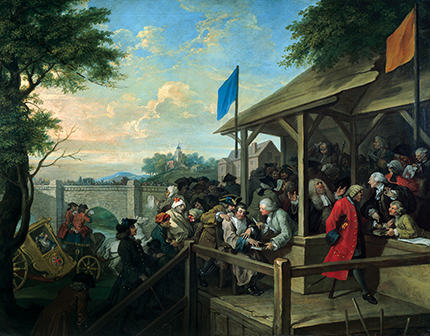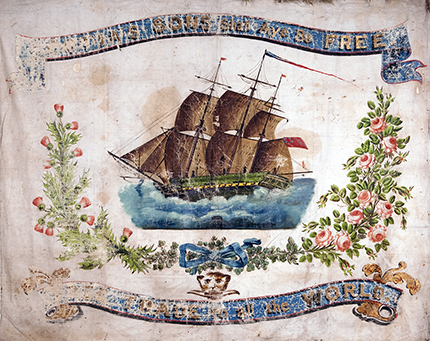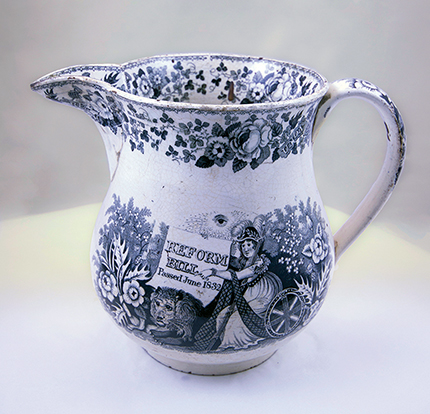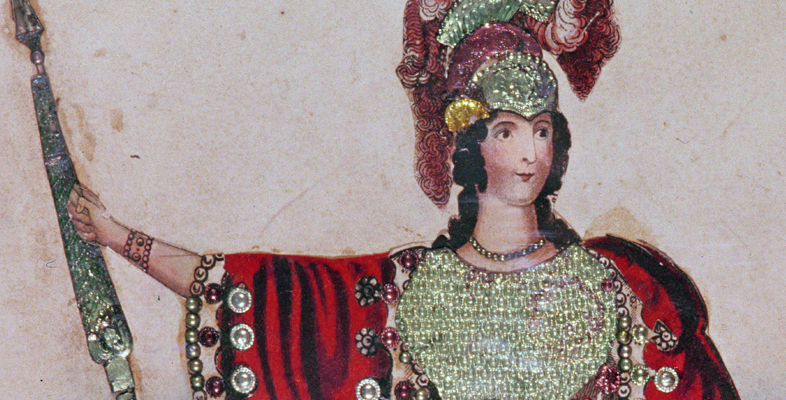4 Parliamentary reform
During the 1820s a national movement to reform the representative system of the United Kingdom gathered pace, culminating in Britain with the Reform Act of 1832, often regarded as one of the most important political events of the nineteenth century (Phillips and Wetherell, 1995). Before this Act, few people in Britain were able to vote. Only adult males had the right to vote. Even then, there were several other obstacles to voting. For instance, the right to vote, or franchise, was linked to the value of property a person owned or rented. Even if a man was qualified to vote, many elections were not contested and, if they were, they were often subject to manipulation by landed interests. Meanwhile, Scotland and Wales were under-represented in Parliament.
The various shortcomings of the electoral system were clear to observers in the eighteenth century. If you take a look at Figure 6 you will see one of a series of four well-known paintings by William Hogarth (1697–1764) depicting an election held in Oxfordshire in 1754. This painting shows voters going on to a stage – the polling station – to publicly declare their choice of candidates. You might notice that in the background of the painting, a carriage bearing the Union flag and carrying Britannia, a female personification of Great Britain, has collapsed.

By the early nineteenth century, the situation seemed to have deteriorated further. As the population had expanded in emerging British industrial cities, the number of seats those areas could return to Parliament came to have no relationship to the size of their population (Phillips and Wetherell, 1995). Calls for the reform of the electoral system in the 1790s were inspired by radical new ideas about popular sovereignty and democracy. Although such radicalism was effectively suppressed by the government in that decade through a combination of press censorship and coercion, towards the end of the Napoleonic Wars economic distress and dissatisfaction with government actions, such as the Corn Laws (1815), helped to revive public interest in the issue of parliamentary reform (Evans, 1999). Reformers organised mass meetings, petitioning campaigns, and appeals to the wider public in print.


Activity 5
In this activity you will analyse two primary sources related to the electoral reform movement. These are a banner carried in demonstrations in Glasgow in favour of electoral reform (Figure 7) and a mass-produced jug commemorating the passage of the Reform Act in June 1832 (Figure 8). Material (physical) objects are important primary sources for historians, so this activity will help you to develop your ability to analyse this type of source. Look at each image carefully, jotting down anything you notice as interesting or unusual.
Then answer the following questions:
- Can you identify symbols of Britishness evident in Figures 7 and 8?
- Why do you think that people campaigning for political reform used symbols of this nature?
Specimen answer
- Scottish thistles are evident to the left of Figure 7, with English roses to the right, and shamrocks symbolising Ireland in the centre. I hope you read the image caption too! You’ll have noted that the banner also proclaimed ‘Britain’s sons shall aye be free’: another appeal to British sentiment.
In Figure 8 you can see Britannia seated by a shield decorated with the Union flag, and a lion, shamrocks, thistles, leeks and roses also adorn the piece.
- By appealing to a shared sense of British identity, campaigners for reform were able to present their cause as a ‘national’ movement, and one that was compatible with the British constitution and British liberties. This helped the movement to attract support from a wide range of people.
Early reform measures in Parliament had faltered due to the strength of Tory opposition. However, in the wake of the general election of 1832, the Whigs, led by Lord Charles Grey (1764–1845, prime minister 1830–34), who had promoted the measure in Parliament, secured a firm majority in the House of Commons. This meant the Reform Bill easily passed through the Commons, but the measure continued to be blocked by the House of Lords. As frustration grew outside of Parliament, rioting broke out in a number of British cities. It was against the background of escalating public unrest that the Lords finally approved the measure. The Reform Bill received the royal assent on 7 June 1832 and separate Reform Acts were subsequently passed for Ireland and Scotland (Phillips and Wetherell, 1995).
In its final form the Reform Act of 1832 increased the electorate in England and Wales from around 366,000 to around 650,000, which was about 18 per cent of the total adult male population. Fifty-six boroughs that had few voters or were controlled by landed interests (so-called ‘rotten boroughs’) were disenfranchised. Thirty small boroughs had the number of seats they could return to Parliament halved. Some of those parliamentary seats were redistributed among counties and urban centres where the population had grown significantly over the previous decades, particularly in the north of England and the Midlands. Wales gained five parliamentary seats and in Scotland eight new boroughs were created, existing boroughs were enlarged, and the electorate was increased from about 5000 to about 65,000 (Colley, 2003). In some ways, the Reform Act of 1832 can be regarded as a victory for a new form of Britishness focused on defending the rights and freedoms guaranteed to the people of the nation by the British constitution. This ‘national identity’ can be seen to have united the interests of vast numbers of English, Scottish and Welsh people, and a wide range of groups within British society, including radicals and the working classes, behind a single cause.
However, not everyone living in the United Kingdom could enjoy the spoils of this victory. The Reform Act mainly benefited the middle classes. The vast majority of adult males, and indeed the vast majority of working-class men in Britain’s industrial towns, were still not able to vote as they did not meet the required property qualifications. Furthermore, voting still took place in public, women were still disenfranchised, and Scotland remained under-represented in Westminster. Meanwhile, the Irish electorate had actually been reduced in size due to concerns about the dangers of popular politics in the country.
